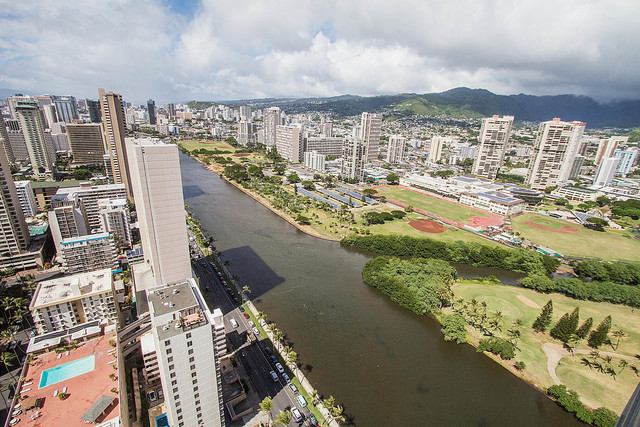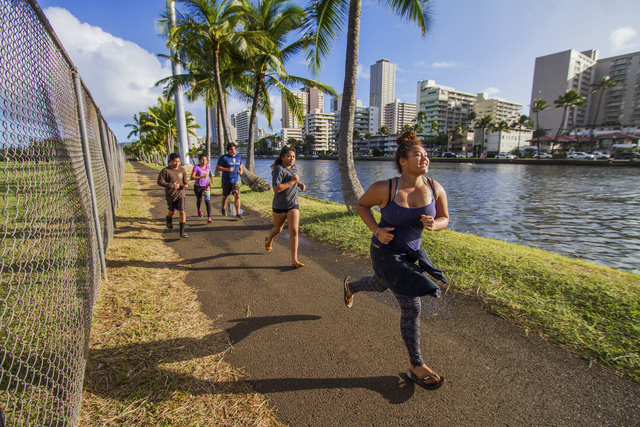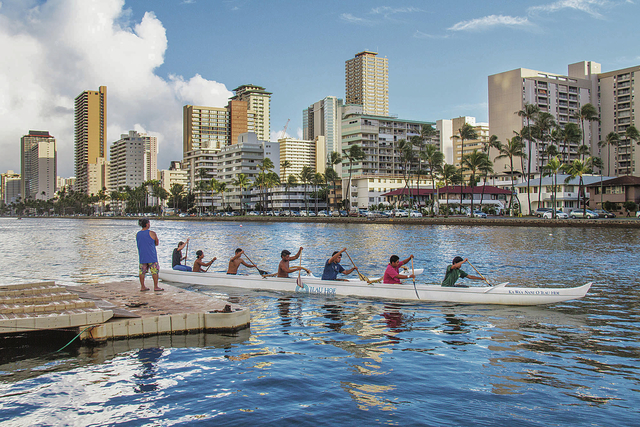The Ala Wai Canal is home to the largest concentration of canoe clubs in the state, yet according to city readings it sometimes has 20 times the level of contaminants considered safe for human recreation.
Nainoa Thompson, president of the Polynesian Voyaging Society, said he remembers paddling down the waterway at age 12 and diving head-first off the McCully Street Bridge into cleaner waters. The canal’s convenience and relatively calm waters still attract scores of paddlers, including 14 canoe clubs. But Thompson avoids the waterway and won’t let his children paddle there, either.
“I know the Ala Wai is not a healthy place. Either let’s go fix it or put up signs and condemn it,” Thompson said Thursday. “Our kids deserve more. We need to restore our waterway and link it to the educational system to create the platform for the next generation of really great navigators.”
The city has been required to test for levels of sewage bacteria in the canal since 2006 to ensure an emergency sewage pipe isn’t leaking. Through 2013, Thompson said, some samples have far exceeded test limits.
Thompson is best known for bringing back the ancient Polynesian art of navigation through the voyages of the Hokule‘a, a Polynesian double-hulled voyaging canoe. The Hokule‘a’s most ambitious journey, the Malama Honua Worldwide Voyage, began in 2013 and is expected to end in June after covering 60,000 nautical miles and stopping in 100 ports in 27 nations.
Thompson is now joining a decades-old movement to improve the Ala Wai Canal watershed with the hope of helping restoration leaders finally bring their voyage home. The Polynesian Voyaging Society, Kyo-ya Hotels &Resorts and the Waikiki Improvement Association launched the Ala Wai Watershed Collaboration last week. They will meet again in December, drawing representatives from the tourism industry, schools, nonprofits and restoration organizations.
“We realize that there are already many amazing efforts underway, but we would like to bring everyone together to discuss and offer input on the best way to work together to make the Ala Wai a clean, healthy waterway,” said Waikiki Improvement Association President Rick Egged.
Hawaii has spent years trying to improve the Ala Wai watershed, a 19-square-mile area that joins water bodies from the ridge of the Koolau Mountains to Mamala Bay’s near-shore waters.
An Army Corps of Engineers Ala Wai Canal flood-mitigation proposal would reduce 100-year flood risks at the man-made waterway, constructed during the 1920s to drain coastal wetlands to develop Waikiki. The plan is among a half-dozen restoration proposals, including the University of Hawaii’s “Make the Ala Wai Awesome” student design challenge.
During the last state Legislature, lawmakers supported the formation of the Ala Wai Watershed Partnership, saying that if a Category 4 hurricane hit Oahu, the damage to Waikiki alone could hit $30 billion. Likewise, a 100-year flood in the dense watershed that feeds the canal could cost an estimated $318 million, affecting about 1,358 acres and more than 3,000 properties.
Heavy rain already causes brown-water advisories and sewage spills that have clogged the canal and temporarily closed Waikiki beaches, said Henry Kruse, a paddling coach for Roosevelt High School and Hui Lanikila, which has 220 members.
“It’s the toilet. Everything gets down into the Ala Wai from the upper streams,” Kruse said. “We have to control upstream contamination and dumping. About a month ago, when we had big rains here, the canal got really, really bad. Three-quarters of the McCully Street Bridge was blocked with debris. You name it, I’ve seen it — logs, sofas, mattresses, baby buggies, shopping carts, mopeds, stuffed animals.”
Thompson hopes to catalyze improvement efforts by ending the Hokule‘a’s worldwide voyage in the Ala Wai Harbor to draw focus to the watershed and the canal.
“There’s no other person in the canoe that I respect more than Nainoa,” Kruse said. “When he pulls into the Ala Wai Harbor, I think it will open a lot of eyes. We all have to work to clean this place up.”






